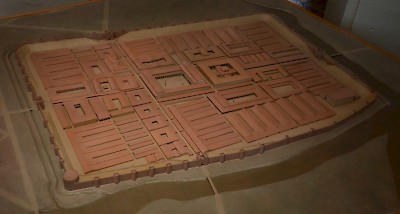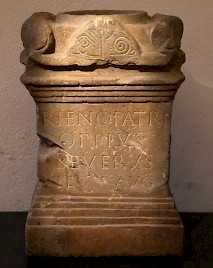Argentoratum (Strasbourg)
Q2860982Argentoratum: Roman legionary base and town on the Upper Rhine, modern Strasbourg in France.
Early History

The fertile loess soil and access to the waters of the rivers Bruche, Ill, and Rhine made the Alsace a natural place for the first farmers. We know that the area was already densely populated in the Bronze Age. The necropolis of Eckbolsheim is just one example of an early settlement. Achaeologists have identified some fifty structures from the Early Iron Age, the Hallstatt Period, at Koenigshoffen, the western and oldest part of Strasbourg.
When Julius Caesar conquered Gaul, he found the Alsace occupied by the Triboci or Triboces, a Germanic tribe that had crossed the Rhine and had settled on the west bank.note In towns like Brumath (ancient Brocomagus) and Haguenau, the presence of Germanic warriors has been confirmed by archaeological finds like weapons in tombs. The Romans built a small military settlement to the east of Koenigshoffen, in the northwest of the current historical center of Strasbourg. This camp measured about six hectares.
Roman Empire

After the battle in the Teutoburg Forest (9 CE), the Romans reorganized the Rhine frontier. The small military settlement became a large legionary fortress, occupied by the Second Legion Augusta and a cavalry unir. This new military base measured some twenty hectares and the presence of II Augusta is documented by the stamps on bricks and rooftiles.
At the same time, Koenigshoffen was rearranged according to the normal Roman layout: a long, straight main road to the fortress (the cardo), parallel roads, and several perpendicular streets (the decumani). All in all, the civil settlement looked like a gridiron. The ancient,Gallic name of this town was Argentoratum; it is mentioned for the first time in an inscription from the reign of the emperor Vespasian (r.69-79).note

During the reign of the emperor Caligula (r.37-41), the army of Germania Superior fought against the Chatti on the Rhine's east bank and several military units were relocated. In 43, the emperor Claudius transferred II Augusta to Britain, and the fortress at Strasbourg was used by other units, like XIIII Gemina and XXI Rapax. Rooftiles and bricks are, again, the main (and not fully conclusive) evidence.
In the year 69, the Year of the Four Emperors, the Batavians revolted, a tribe living along the Lower Rhine and Waal. The insurrection spread upstream to the south and the Triboci were unquiet too. However, in 70, the Roman general Cerialis restored order and Strasbourg, which had been destroyed by fire, became the base of a new unit: the Eighth Legion Augusta, arriving from Novae on the Middle Danube, was to stay here for three centuries, guarding an important crossing point of the Rhine. Meanwhile, some of the original inhabitants, the Triboci, were serving as exploratores in the Agri Decumates (i.e., on the east bank of the Rhine in the Black Forest).note
By now, the civil settlement Koenigshoffen had become a very large town, almost three kilometers long. Most inhabitants must have been farmers. Archaeologists have found traces of the centuriation, the square Roman fields, on several places in the neighborhood. Many reliefs and statues document the religious beliefs of the inhabitants of Argentoratum: several old Celtic gods were still venerated, like Rosmerta, or were venerated under their Latin names (e.g., Mercury for Lug). Three Mithraic reliefs are evidence for the cult of this eastern light god.
Late Antiquity

In the third century, the civil settlement started to contract. This must be evidence for a decline in population that is also attested everywhere along the Rhine. It is possible that the people had grown afraid of the new Germanic tribes on the east bank, like the Alamans, who conquered the Black Forest and now lived just across the river. The Roman defences were seriously weakened, but a general named Postumus (r.260-269) created some order and founded a "Gallic Empire" that survived its creator.
Rooftiles from the third or fourth century document the presence of a unit that is called the Twelfth Legion Victrix. Perhaps, this legion was created by the by the emperors of the Gallic Empire, but the emperors Constantius I Chlorus (r.293-306) and Constantius II (r.337-361) are other plausible candidates. In any case, Strasbourg was a bulwark against the Germanic tribes. In 357, a general named Julian (the future emperor) defeated the Alamans just west of Argentoratum.
However, in the fifth century, the city, which had in the meantime become the seat of bishop, was taken over by the Germans, who started to call it Stratisburgum. After the battle of Tolbiac, at the end of the fifth century, the Alamans were subjects of the Frankish Empire.











































